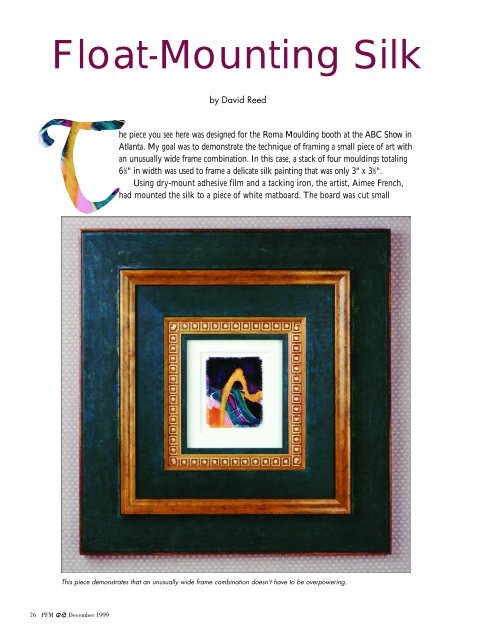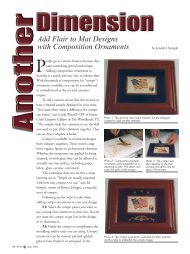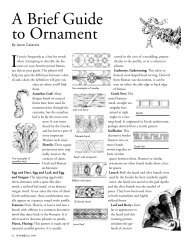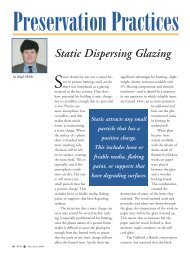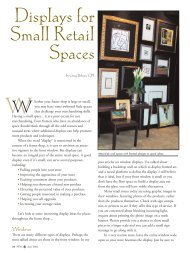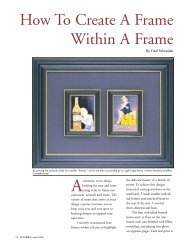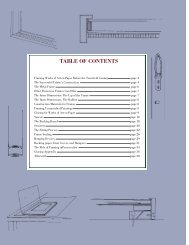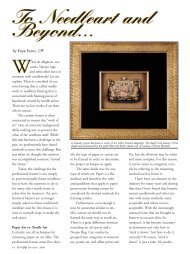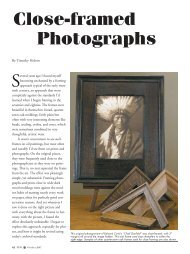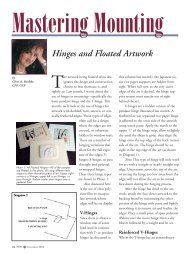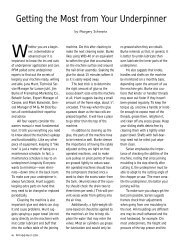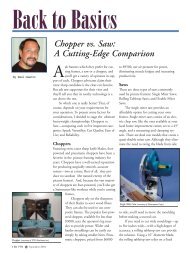Float-Mounting Silk - Picture Framing Magazine
Float-Mounting Silk - Picture Framing Magazine
Float-Mounting Silk - Picture Framing Magazine
Create successful ePaper yourself
Turn your PDF publications into a flip-book with our unique Google optimized e-Paper software.
<strong>Float</strong>-<strong>Mounting</strong> <strong>Silk</strong><br />
by David Reed<br />
he piece you see here was designed for the Roma Moulding booth at the ABC Sh ow in<br />
Atlanta. My goal was to demonstrate the technique of framing a small piece of art with<br />
an unusually wide frame combination. In this case, a stack of four mouldings totaling<br />
6 1 ⁄2" in width was used to frame a delicate silk painting that was only 3" x 3 1 ⁄2" .<br />
Using dry-mount adhesive film and a tacking iron, the artist, Aimee Fre n c h ,<br />
had mounted the silk to a piece of white matboard. The board was cut small<br />
This piece demonstrates that an unusually wide frame combination doesn’t have to be overpowering.<br />
76 PFM i December 1999
enough to suspend the<br />
silk without extending<br />
so close to the edge<br />
that it would become<br />
visible.<br />
I took French’s<br />
mounted silk and<br />
added another layer of<br />
matboard for depth;<br />
then, using ATG tape,<br />
mounted the entire<br />
package to a backing<br />
board of 8-ply white<br />
matboard. Finally, I<br />
added a 1 1 ⁄8" mat with a<br />
window opening large<br />
enough to allow 1 ⁄2" of<br />
space around the edges<br />
of the silk. The mounted<br />
and matted artwork<br />
was framed by four<br />
mouldings, stacked<br />
from the image out as<br />
follows: Roma 2998,<br />
24455, 6098 and<br />
58198. Glass was then placed between the mat and the<br />
interior frame.<br />
I knew that in my effort to showcase the moulding I<br />
ran the risk of overpowering the art. I wanted the silk to<br />
retain its own identity as an independent, three-dimensional<br />
item, separate from the frame that surrounded it.<br />
By floating the silks above their backgrounds, French<br />
is able to reveal their fine, frayed edges, an effect I would<br />
have destroyed if I had “trapped” these edges under a<br />
mat. Instead, I chose to emphasize this by raising the silk<br />
even higher. In this way, I was able, not only to draw<br />
greater attention to the silk’s frayed edges, but also to create<br />
the illusion that it was “floating.” Thus, the true personality<br />
of the silk and its juxtaposition against a heavy<br />
frame actually seemed to underscore its delicacy.<br />
Other Uses For <strong>Float</strong>-Mounts<br />
The floating of French’s silk is just one example of how<br />
the relatively simple technique of float-mounting can be<br />
used to make a huge difference in the appearance of a<br />
framed piece. <strong>Float</strong>-mounting works well any time an<br />
item has a distinct or unusual edge, including sheets of<br />
78 PFM i December 1999<br />
deckled paper,<br />
papyrus, postage<br />
stamps and perforated<br />
ticket stubs.<br />
<strong>Float</strong>-mounting<br />
can be especially useful<br />
in helping a piece<br />
achieve a feeling of<br />
depth. Any seemingly<br />
flat item or sheet of<br />
paper is actually<br />
three-dimensional,<br />
even if its image only<br />
extends across two<br />
dimensions. Oftentimes,<br />
such items are<br />
interesting not just as<br />
images, but as objects<br />
containing images.<br />
Examples include<br />
dollar bills, baseball<br />
cards, old photographs,<br />
documents,<br />
sketches, love letters<br />
and wedding invitations.<br />
Essentially, any item that might ordinarily be<br />
trapped under a mat can be brought into the third<br />
dimension by being placed over a mat and lifted slightly.<br />
Again, the effect can be striking and is seldom difficult to<br />
achieve.<br />
Even in cases where it is not desirable to float the<br />
item being framed, a feeling of depth can be created by<br />
simply floating a mat. If a print of an Ansel Adams photograph,<br />
for example, is double matted with the top mat<br />
floating slightly, the result is the illusion that the image is<br />
sitting back, at a distance. In this way, the eye of the<br />
beholder is more easily tricked into believing that it is<br />
standing in the midst of a living landscape, not just looking<br />
at a flat image.<br />
Time and time again, I have found that creating a<br />
feeling of depth can make the difference between a<br />
decent framing job and one that pulls a gasp out of my<br />
c u s t o m e r. <strong>Float</strong>ing art w o rk and mats are an easy and<br />
i n e x p e n s i ve way to raise a framed piece to this level. ■<br />
The frayed edges of Aimee French’s silk painting were emphasized by mounting the<br />
piece to matboard, which also gave it a “floating” appearance.<br />
David Reed has been framing in partnership with his father, Edsel Reed, since<br />
1986. He is the owner of Fine Frames of Duluth, Atlanta.


